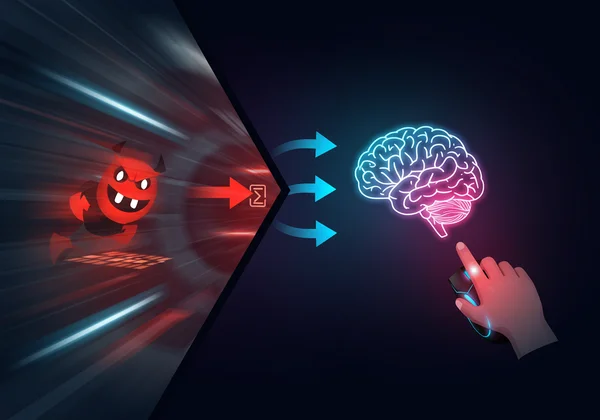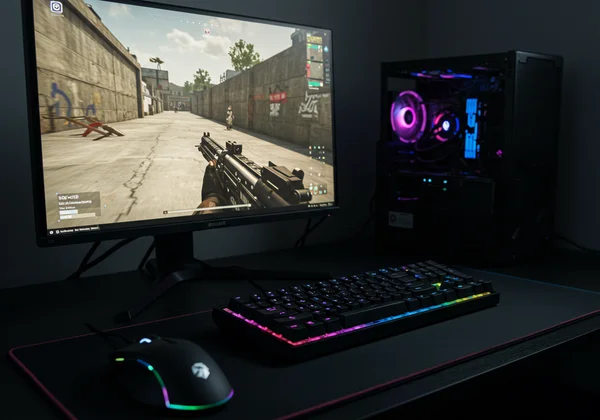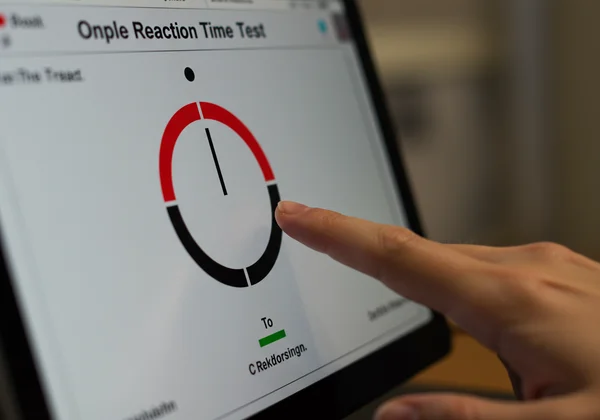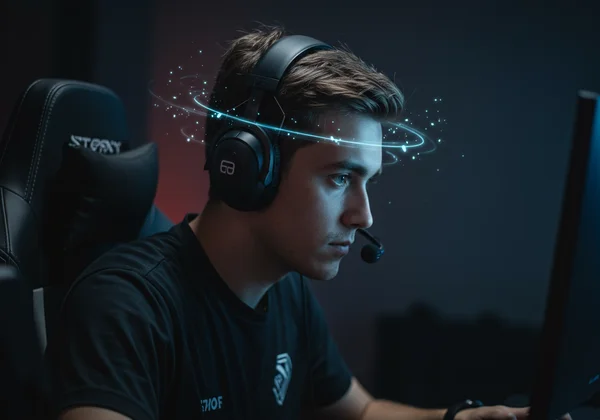Improve Your Gaming Reaction Time: The Ultimate Reflex Guide & Reaction Time Test
In the world of competitive gaming, victory and defeat are often decided in a fraction of a second. That last-second headshot, the perfectly timed parry, or the split-second dodge can be the difference between climbing the ranks and a frustrating loss. The core skill behind these clutch plays is reaction time. Mastering your reaction time for gaming isn't just an advantage; it's a necessity. Are you ready to turn those critical milliseconds into consistent victories? This guide reveals the strategies to hone your reflexes and conquer your opponents. You can start by getting a baseline with a reaction speed test.
Why Reaction Time is Your Gaming Superpower
Before diving into how to improve, it’s crucial to understand what reaction time means in a gaming context. It’s not just about how fast you can click a mouse. It's the entire process: perceiving a stimulus (seeing an enemy), processing the information in your brain (deciding to shoot), and executing a physical action (clicking the mouse). This entire sequence determines your in-game responsiveness.

Simple vs. Choice Reaction: The Gaming Difference
In gaming, we encounter two main types of reactions. Simple reaction time is your response to a single, expected stimulus, like clicking as soon as a light turns green. This is the foundation of your raw reflex speed. Choice reaction time is more complex and far more common in games. It involves choosing the correct response from multiple options, such as deciding whether to shoot, take cover, or use an ability when an opponent appears. Improving both is key to becoming a formidable player.
Understanding Input Lag & Latency
Your personal reaction time is only part of the equation. System latency, often called input lag, is the delay between your physical action (moving your mouse) and the corresponding action appearing on screen. This is influenced by your hardware. Network latency, or ping, is the delay in communication between your computer and the game server in online matches. Minimizing both is essential for your reflexes to translate effectively in-game.
Optimize Your Gear for Blazing Fast Reflexes
Your gaming setup can either be a powerful asset or a significant bottleneck. A player with 150ms reflexes can be handicapped by a slow monitor and mouse, effectively giving them the reaction speed of a 200ms player. Optimizing your gear is the first and most tangible step you can take to improve your gaming reaction time.

Monitor Refresh Rate & Response Time: The Visual Edge
Your monitor is your window to the game world. A higher refresh rate (measured in Hz) means the image on your screen updates more frequently each second. Upgrading from a 60Hz to a 144Hz or 240Hz monitor means you see enemies sooner, giving your brain more time to react. Similarly, a low response time (measured in ms) reduces motion blur, making fast-moving targets clearer and easier to track.
Mouse, Keyboard & Controller: Reducing Input Delay
Your peripherals are the direct link between your brain and the game. Gaming mice with high polling rates (1000Hz or more) report their position to the computer more frequently, reducing input delay. Mechanical keyboards offer faster actuation than traditional membrane keyboards. For controller players, using a wired connection instead of Bluetooth can significantly cut down on latency and give you a competitive edge.
Internet Connection & Ping: Minimizing Online Lag
For online gamers, a low and stable ping is non-negotiable. A high ping means your actions take longer to register on the server, putting you at a severe disadvantage. Whenever possible, use a wired Ethernet connection instead of Wi-Fi for a more stable and faster connection. Closing background applications that use bandwidth can also help reduce your ping during intense gaming sessions.
Proven Reaction Time Training Strategies for Gamers
Once your hardware is optimized, it's time to train your most important piece of equipment: your brain. Just like a muscle, your reflexes can be sharpened with consistent and deliberate practice. Integrating specific drills into your routine is the secret to unlocking lightning-fast reaction speed.

Online Reaction Tests & Daily Drills
The single best way to build a foundation is through targeted drills. Using an online reaction time game provides a pure, distraction-free environment to measure and improve your simple reaction time. Make it a daily habit. Spend 5-10 minutes before your gaming sessions on a click test to warm up your nervous system. Tracking your average score over time is the best way to see tangible progress.
Game-Specific Practice: FPS vs. MOBA vs. Fighting Games
Raw reflex speed is great, but it must be applied to in-game scenarios.
- FPS Players: Use aim trainers like KovaaK's or Aim Lab to practice flick shots and target switching. In-game, focus on holding tight angles and pre-aiming common spots to reduce the distance your crosshair needs to travel.
- MOBA Players: Practice in custom games to master dodging skillshots. Load up a practice tool and focus solely on reacting to enemy abilities without the pressure of a real match.
- Fighting Game Players: Spend time in training mode practicing hit confirms and blocking mix-ups. This builds the crucial muscle memory needed to react to an opponent's combos instinctively.
Deliberate Practice & Post-Game Analysis
Mindlessly grinding games won't make you faster. Deliberate practice involves focusing on a single weakness during a session. If your goal is to improve reaction time, actively look for situations that test it. After a match, watch your replays. Identify moments where your reaction was slow and ask why. Did you not see the enemy? Were you unfocused? Analyzing your mistakes is critical for improvement.
The Mental Edge: Focus, Consistency & Wellbeing
Your physical and mental state has a massive impact on your cognitive performance, including reaction time. Professional gamers treat themselves like athletes because peak performance requires a holistic approach that goes beyond the game itself.

Sharpening Your Attention and Anticipation
A huge part of reacting quickly is anticipating what might happen next. This is called game sense. By understanding maps, character abilities, and common player strategies, you can predict enemy movements. This allows your brain to prepare for a stimulus before it even happens, dramatically cutting down your reaction time. Staying focused and avoiding distractions is key to maintaining this high level of awareness.
Sleep, Nutrition & Hydration: Fueling Your Reflexes
Science is clear on this: a lack of sleep significantly slows reaction time. Aim for 7-9 hours of quality sleep per night. Proper nutrition and hydration are also vital. Dehydration can impair cognitive function, so keep a water bottle nearby. Complex carbohydrates provide sustained energy, while caffeine, in moderation, can provide a temporary boost to alertness.
Warm-ups & Stress Management for Peak Performance
Never jump into a ranked match cold. A proper warm-up routine prepares both your body and mind. This should include a few minutes with a reaction time trainer and some in-game practice drills. Learning to manage stress is also crucial. When you're tilted or anxious, your reaction time suffers. Deep breathing exercises between rounds can help you stay calm and focused under pressure.
Achieving Esports Reaction Time: What the Pros Do
Aspiring players often wonder how their reflexes stack up against the best in the world. While professional players do have exceptional genetics, their consistency comes from thousands of hours of dedicated and intelligent training.
What's Considered a "Pro" Level Reaction Speed?
For simple visual stimuli, the average human reaction time is around 200-250ms. Many professional esports athletes consistently score between 120ms and 160ms on a human reaction test. However, it's important to remember that in-game decisions are far more complex. Pro players excel because their incredible game sense allows them to anticipate and react faster in choice-reaction scenarios, not just because of raw click speed.
Maintaining Consistency Under Pressure
The true mark of a pro is not just having fast reactions, but being able to access them consistently, especially in high-stakes tournament finals. This mental fortitude is built through experience, stress management techniques, and unwavering confidence in their training. They have honed their skills to the point where reacting becomes second nature, freeing their minds to focus on higher-level strategy.
Your Path to Gaming Mastery Starts Now
Your path to becoming a faster, more dominant gamer starts today. Don't let precious milliseconds slip away. Put these strategies into practice, track your progress, and prepare to see your in-game performance soar.
Your first step is to establish a baseline with our online reaction time test. Head over to measure your speed and see where you stand. From there, commit to the process, track your progress, and watch as your in-game performance reaches new heights.
Frequently Asked Questions About Gaming Reaction Time
What is a good reaction time for gaming?
While pro gamers often score below 160ms in a controlled reaction time test, a score between 180-220ms is considered very good for a competitive player. However, don't fixate on just one number. Consistency and how your reflexes translate to complex in-game decisions are far more important. The goal should be personal improvement, which you can track with our online tool.
How can I improve my reaction time for gaming without special equipment?
You can make significant gains without a new setup. The biggest improvements come from consistent practice with online tools like a reflex test, getting adequate sleep, staying hydrated, and focusing on in-game anticipation. Deliberate practice and analyzing your gameplay are free and incredibly effective.
Does higher FPS really affect your reaction time in games?
Yes, absolutely. Higher Frames Per Second (FPS), combined with a high refresh rate monitor, provides you with more up-to-date visual information. This means you can see an enemy emerge from a corner milliseconds sooner than a player with lower FPS, giving you a direct and measurable advantage in reaction time.
Is fast reaction time genetic, or can it be trained?
It's a mix of both. While genetics may set a certain baseline potential for your nervous system response, your effective reaction time is highly trainable. Through consistent practice, you can optimize your neural pathways, improve hand-eye coordination, and develop game sense to significantly enhance your reactive capabilities. Anyone can improve with dedicated effort.